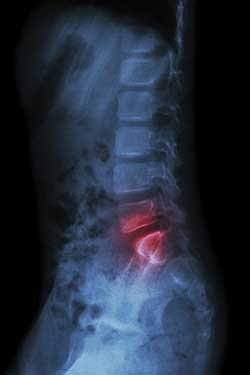Selective Epidural Injections in Davie, FL

Back pain can be debilitating. To help those who suffer from intolerable back pain, an injection known as a selective nerve root block (SNRB)/transforaminal epidural steroid injection—sometimes simply called a selective epidural or SNRB—has been adapted from diagnostics to relieve chronic pain.
Unlike a regular cortisone injection, a selective epidural is an injection placed close to the nerves of the spine. Like a highway with exit ramps, the spinal cord too has exits where nerves branch out to different parts of the body. These nerve exits are called foramen, basically small bone tunnels where nerves leave the vertebrae. This is the site of injection, a far more delicate procedure than a regular corticosteroid injection.
What will a Selective Epidural or SNRB Treat?
A selective epidural can be used to treat a number of pain causing injuries and conditions, including:
- Neck pain
- Lower back pain (known as axial pain)
- Spinal stenosis
- Sciatica
- Herniated disc
- Degenerative disc disease
- Pain from a bone spur
- Arm, chest and leg pain
Treatment Procedure for SNBR
First a detailed medical history will typically be obtained, asking about the current medications you're taking, your pain, etc. The actual procedure starts with an anesthetic (sometimes administered orally or via an IV). Depending on the office, you may be required to lay on an X-ray table (fluoroscopy or computer tomography in the case of a lumbar or nerve root injection may be used).
Using the X-ray guidance, a needle is injected close to the nerve root (in the foramen) and a contrast dye is injected to make sure the right nerve has been located. If it is the right nerve, a cocktail of numbing agent (lidocaine) and time release/ long acting cortisone (anti-inflammatory steroid) are injected to numb your pain and reduce inflammation .
In total, the procedure itself can be expected to take no longer than an hour, with complete—or near complete—pain reduction occurring in under a week. The painkilling effects can last from days to months, the average lasting six-months sometimes more. No two patients are alike.
After the procedure you will not be able to drive home because some limb weakness/ numbness may be present, so have a friend, family member or taxi on standby.
Selective Epidural Side effects
Like any procedure there are side effects, they are rare, but worth mentioning. They include:
- Insomnia
- Elevated blood glucose
- Bleeding (a risk with those on blood thinners)
- Infection
- Intense pain in the arm or leg (this is a short lived but strong pain)
- Increase in the pain you're trying to treat
- Kidney failure
- Bladder dysfunction
- Bowel dysfunction
- Paralysis
- Wet Tap (a leaking of cerebral spinal fluid)
- Death (a risk with most surgical procedures)
In addition to these possible side effects, a selective epidural is not recommended for long term pain management (the SNRB was originally designed as a diagnostic test, stopping communication of nerves to find the source of pain). The injection of a steroid can cause deterioration over time and interfere with hormonal balance. For this reason, injections are typically limited to three in a six-month time frame.
That said, for many, these risks pale in comparison to the extreme pain affecting their daily lives. If you suffer from constant, debilitating pain, a selective epidural or SNBR may be the pain relief treatment for you.
Request more information about a Selective Epidural today. Call (561) 623-9344 or contact Advanced Medical Therapeutics LLC online.
Advanced Medical Therapeutics LLC
Address
6100 Glades RoadSuite 304
Boca Raton, FL 33434
(561) 623-9344
www.amtcare.com
Hours
Mon:
8:30 am - 4:30 pm
Tue:
8:30 am - 4:30 pm
Wed:
8:30 am - 4:30 pm
Thu:
8:30 am - 4:30 pm
Fri:
8:30 am - 4:30 pm

